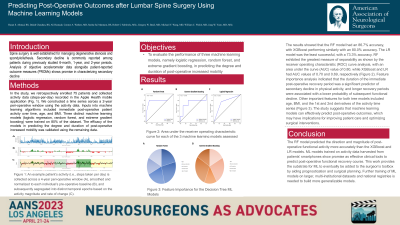Predicting Post-Operative Outcomes after Lumbar Spine Surgery Using Machine Learning Models
Predicting Post-operative Outcomes After Lumbar Spine Surgery Using Machine Learning Models
Friday, April 21, 2023


Hasan S. Ahmad, BS
Medical Student
University of Pennsylvania
Philadelphia, Pennsylvania, United States
ePoster Presenter(s)
Introduction: Currently, subjective patient-reported outcome measures are the main form of outcome assessment in spine surgery. Passively and continuously collected patient mobility data can effectively supplement these patient questionnaires by objectively quantifying patient functional recovery. In this study, we developed machine learning (ML) models to predict the direction and magnitude of post-operative functional activity.
Methods: Patients were retroactively consented and enrolled. Activity data (steps-per-day) recorded in the Apple Health (Apple Inc., Cupertino, CA) mobile application was used to construct a time series across a 2-year peri-operative window. Inputs into ML algorithms included patient activity over time, age, and BMI. Three distinct ML models – logistic regression (LR), random forest (RF), and extreme gradient boosting (XGBoost) were each trained on 80% of the dataset, and their efficacy in predicting the degree and duration of post-operative increased mobility was validated using the remaining data.
Results: A total of 41 patients were included. Following training, the XGBoost and LR models both achieved a predictive accuracy of 88.9% (sensitivity 85.7%, specificity 100%), while RF model accuracy was 66.7% (sensitivity 62.5%, specificity 100%). Receiving operator characteristic curves showed an area under the curve, a measure of a classifier model's effectiveness, of 0.83 for both LR and XGBoost models and of 0.73 for the RF model.
Conclusion : LR and XGBoost models predicted the direction and magnitude of post-operative functional activity with greater accuracy than the RF model. ML models trained on objective activity data show promise as effective clinical tools to predict post-operative recovery course, though further validation on larger datasets is needed. These ML models may be leveraged to prognosticate patients with various spine pathologies and proposed surgical interventions. Further training of ML models on larger, multi-institutional datasets or national registries is needed.
Methods: Patients were retroactively consented and enrolled. Activity data (steps-per-day) recorded in the Apple Health (Apple Inc., Cupertino, CA) mobile application was used to construct a time series across a 2-year peri-operative window. Inputs into ML algorithms included patient activity over time, age, and BMI. Three distinct ML models – logistic regression (LR), random forest (RF), and extreme gradient boosting (XGBoost) were each trained on 80% of the dataset, and their efficacy in predicting the degree and duration of post-operative increased mobility was validated using the remaining data.
Results: A total of 41 patients were included. Following training, the XGBoost and LR models both achieved a predictive accuracy of 88.9% (sensitivity 85.7%, specificity 100%), while RF model accuracy was 66.7% (sensitivity 62.5%, specificity 100%). Receiving operator characteristic curves showed an area under the curve, a measure of a classifier model's effectiveness, of 0.83 for both LR and XGBoost models and of 0.73 for the RF model.
Conclusion : LR and XGBoost models predicted the direction and magnitude of post-operative functional activity with greater accuracy than the RF model. ML models trained on objective activity data show promise as effective clinical tools to predict post-operative recovery course, though further validation on larger datasets is needed. These ML models may be leveraged to prognosticate patients with various spine pathologies and proposed surgical interventions. Further training of ML models on larger, multi-institutional datasets or national registries is needed.
